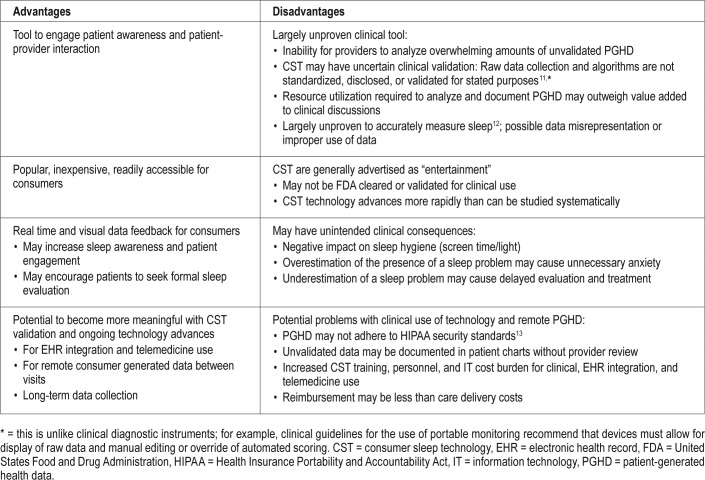Modern technology has led to an increase in consumer sleep technology (CST). Various forms include sleep tracking applications and wearable devices. Most CST devices are not FDA-approved. None of these have been adequately tested among patients with insomnia. As such, these tools should not be used as substitutes for medical evaluation.1 However, CSTs can be used to provide additional information to enhance the patient-provider interaction.
The American Academy of Sleep Medicine (AASM) summarizes the advantages and disadvantages of CST in the chart below1:

Table courtesy and permission provided by JCSM. Access article at: https://doi.org/10.5664/jcsm.7128.
Light Exposure Before Bedtime
Light exposure especially from electronic devices close to bedtime can disrupt your circadian rhythm. The circadian rhythm is the body’s internal clock that either signals alertness or prepares you for rest. Light inhibits the secretion of the hormone melatonin from the pineal gland in the brainstem. Melatonin is the signal to the internal clock that it is time to sleep. Blue enriched light which radiates from electronic devices is particularly effective in delaying melatonin secretion. Research has shown that use of electronic devices delays the onset of sleep and can be a factor in precipitation or perpetuation of insomnia.
Dr. Charles Czeisler describes how electronic reading devices can worsen sleep.
Sleep Tracking Devices
Technology has increased the amount of sleep data available to the individual. A recent study of healthy participants showed a sleep tracking application to sufficiently measure sleep and heart rate variables.2 More ongoing studies are assessing the efficacy and benefits of using sleep tracking applications for sleep disorders.3
Sleep tracking devices often contain a sensor (accelerometer) that records your movements. This accelerometer is the essential component of an actigraph (watch video on actigraphy), a device which sleep specialists and researchers use to estimate sleep patterns over extended periods of time. Generally, it interprets your lack of movement as “sleep” and movements like tossing and turning as “awake.” These devices can provide sleep information in your natural sleep environment. However, the data from these devices and other CSTs should be considered as only estimates of one's sleep. They should never be used instead of clinical interviews, sleep diaries, or overnight sleep studies when indicated.
References
- Khosla S, et al. "Consumer sleep technology: an American Academy of Sleep Medicine position statement." J Clin Sleep Med. 2018; 14(5): 877-880. https://doi.org/10.5664/jcsm.7128.
- Berryhill S, et al. "Effect of wearables on sleep in healthy individuals: a randomized crossover trial and validation study." J Clin Sleep Med. 2020; 16(5): 775-783.
- Collen, Jacob F, York CM. "Wrist Wearables: More Questions than Answers?." J Clin Sleep Med. 2019; 15(8): 1077-1078.